|
|
Space Astro
|
Info for exoplanet "Sityh Itase"
| Scientific (actual) data |
|---|
| Name | TOI-1199 b |
| Planet status | Confirmed |
| Planet mass | 0.239 |
| Radius | 0.938 |
| Orbital period | 3.67146 |
| Semi major axis | 0.04988 |
| Orbit eccentricity | 0.03 |
| Discovered | 2024 |
| Updated | 2024-02-13 |
| Omega | 57 |
| Tzero tr | 2459420 |
| Impact parameter | 0.849 |
| K | 27.5 |
| Temperature (kelvin) | 1486 |
| Publication | Published in a refereed paper |
| Detection type | Primary Transit |
| Mass measurement type | Radial Velocity |
| Radius measurement type | Primary Transit |
| Star name | TOI-1199 |
| Right ascension | 166.88° |
| Declination | 61.35° |
| Mag v | 11 |
| Star distance | 247 |
| Star metallicity | 0.44 |
| Star mass | 1.23 |
| Star radius | 1.45 |
| Star age | 4.2 |
| Star temperature | 5710 |
| Wikipedia article | TOI-1199 b |
Back
| |
| Fictional info (?) |
|---|
| Suggested name | Sityh Itase |
| Planet type | Hot gas giant |
| As seen relative to the fixed stars, it rotates on its axis exactly five times for every two revolutions it makes around TOI-1199.
Having almost no atmosphere to retain heat, it has surface temperatures that vary diurnally more than on any other planet in its solar system, ranging from 85°K (-188°C) at night to 735°K (462°C) during the day across the equatorial regions.
.
A prominent result is the "great green spot", a giant storm that is known to have existed for centuries since it was first observed by radar.
lengthy journey. |
| Atmosphere | Carbon monoxide | 99% |
| Atmospheric pressure | 0.23 bar |
 |
| No known satellites |
| Google search for Sityh itase |
|
Website by Joachim Michaelis
|
|
|
|